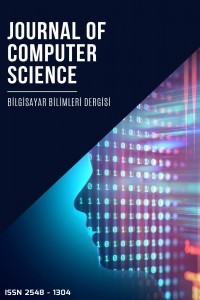A New Approach Based on Centrality Value in Solving the Maximum Independent Set Problem: Malatya Centrality Algorithm
Maximum independent set, Graph theory, Malatya centrality algorithm, Malatya centrality value.
A New Approach Based on Centrality Value in Solving the Maximum Independent Set Problem: Malatya Centrality Algorithm
Maximum independent set, Graph theory, Malatya centrality algorithm, Malatya centrality value.,
___
- Alkhouri, I. R., Atia, G. K., & Velasquez, A. (2022). A differentiable approach to the maximum independent set problem using dataless neural networks. Neural Networks, 155, 168–176. Retrieved from https://doi.org/10.1016/j.neunet.2022.08.008
- Araujo, F., Farinha, J., Domingues, P., Silaghi, G. C., & Kondo, D. (2011). A maximum independent set approach for collusion detection in voting pools. Journal of Parallel and Distributed Computing, 71(10), 1356–1366. Retrieved from https://doi.org/10.1016/j.jpdc.2011.06.004
- Ballard-myer, J. C. (2019). Deterministic Greedy Algorithm for Maximum Independent Set Problem in Graph Theory, 1–14.
- Borgatti, S. P. (2005). Centrality and network flow. Social Networks, 27(1), 55–71. Retrieved from https://doi.org/10.1016/j.socnet.2004.11.008
- Brandstädt, A., & Mosca, R. (2018). Maximum weight independent set for lclaw-free graphs in polynomial time Discrete Applied Mathematics, 237, 57–64. Retrieved from https://doi.org/10.1016/j.dam.2017.11.029
- Cormen, T. H., Leiserson, C. E., Rivest, R., & Clifford, S. (2001). Introduction to algorithms (Introducti). London.
- Das, G. K., De, M., Kolay, S., Nandy, S. C., & Sur-Kolay, S. (2015). Approximation algorithms for maximum independent set of a unit disk graph. Information Processing Letters, 115(3), 439–446. Retrieved from https://doi.org/10.1016/j.ipl.2014.11.002
- Großmann, E., Lamm, S., Schulz, C., & Strash, D. (2022). Finding Near-Optimal Weight Independent Sets at Scale. Retrieved from http://arxiv.org/abs/2208.13645
- Joo, C., Lin, X., Ryu, J., & Shroff, N. B. (2016). Distributed Greedy Approximation to Maximum Weighted Independent Set for Scheduling With Fading Channels. IEEE/ACM Transactions on Networking, 24(3), 1476–1488. Retrieved from https://doi.org/10.1109/TNET.2015.2417861
- Karci, A. (2020). Efficient Algorithms for Determining the Maximum Independent Sets in Graphs. Computer Science, 5(2), 144–149.
- Karci, A. (2022). Verification of Karci Algorithm’s Efficiency for Maximum Independent Set Problem in Graph Theory. Computer Science, 20–28. Retrieved from https://doi.org/10.53070/bbd.1090368
- Karcı, A., Yakut, S., & Öztemiz, F. (2022). A New Approach Based on Centrality Value in Solving the Minimum Vertex Cover Problem: Malatya Centrality Algorithm. Computer Science, 55(35), 1–100. Retrieved from https://doi.org/10.53070/bbd.1195501
- Kumar, G., Duhan, N., & Sharma, A. K. (2011). Page ranking based on number of visits of links of Web page. In 2011 2nd International Conference on Computer and Communication Technology (ICCCT-2011) (pp. 11– 14). IEEE. Retrieved from https://doi.org/10.1109/ICCCT.2011.6075206
- Lamm, S., Schulz, C., Strash, D., Williger, R., & Zhang, H. (2019). Exactly Solving the Maximum Weight Independent Set Problem on Large Real-World Graphs. In 2019 Proceedings of the Twenty-First Workshop on Algorithm Engineering and Experiments (ALENEX) (Vol. January, pp. 144–158). Philadelphia, PA: Society for Industrial and Applied Mathematics. Retrieved from https://doi.org/10.1137/1.9781611975499.12
- Li, Z., He, G., Xu, D., & Wang, S. (2020). Evaluation of Centralized Reader Anti-Collision Protocols for Mobile RFID System Based on Maximum Independent Set: A Simulation Study. IEEE Access, 8, 123381–123397.23 Retrieved from https://doi.org/10.1109/ACCESS.2020.3006162
- Thulasiraman, K., & Swamy NS, M. (2011). Graphs: theory and algorithms. Montreal: John Wiley & Sons.
- Uçkan, T., & Karcı, A. (2020). Extractive multi-document text summarization based on graph independent sets. Egyptian Informatics Journal, 21(3), 145–157. Retrieved from https://doi.org/10.1016/j.eij.2019.12.002
- Wan, P., Tu, J., Zhang, S., & Li, B. (2018). Computing the numbers of independent sets and matchings of all sizes for graphs with bounded treewidth. Applied Mathematics and Computation, 332, 42–47. Retrieved from https://doi.org/10.1016/j.amc.2018.03.017
- Xiao, M., & Nagamochi, H. (2017). Exact algorithms for maximum independent set. Information and Computation, 255, 126–146. Retrieved from https://doi.org/10.1016/j.ic.2017.06.001
- ISSN: 2548-1304
- Yayın Aralığı: Yılda 2 Sayı
- Başlangıç: 2016
- Yayıncı: Ali KARCI
LBP Özellik Çıkarma ve İstatistiksel Havuzlama Tabanlı Görüntü Spam Tespit Modeli
Parçacık Sürü Optimizasyonu Yoluyla Geliştirilen Doğrusal Bir Sınıflandırıcının Analizi
Selman YAKUT, Furkan ÖZTEMİZ, Ali KARCİ
Geri Çekildi: 5G Sistemleri için DL Tabanlı Kanal Tahmini
Şeyda KARCI, Fatih OKUMUŞ, Ali KARCİ
Güç Sistemlerinde Farklı Enerji Depolama Seviyelerinde Sistem Kararlılığının İncelenmesi
